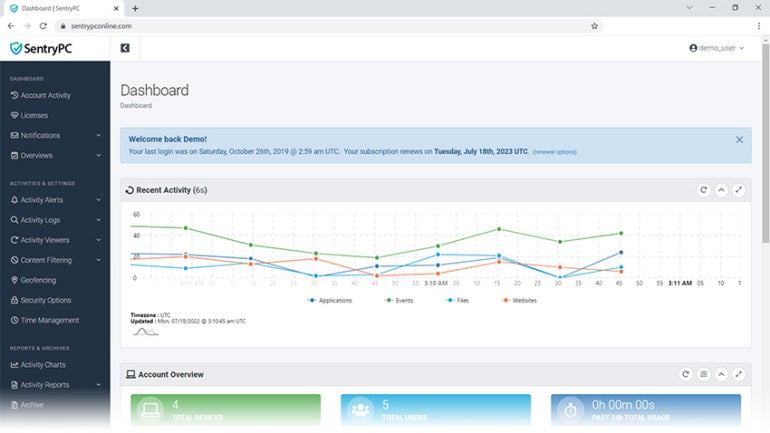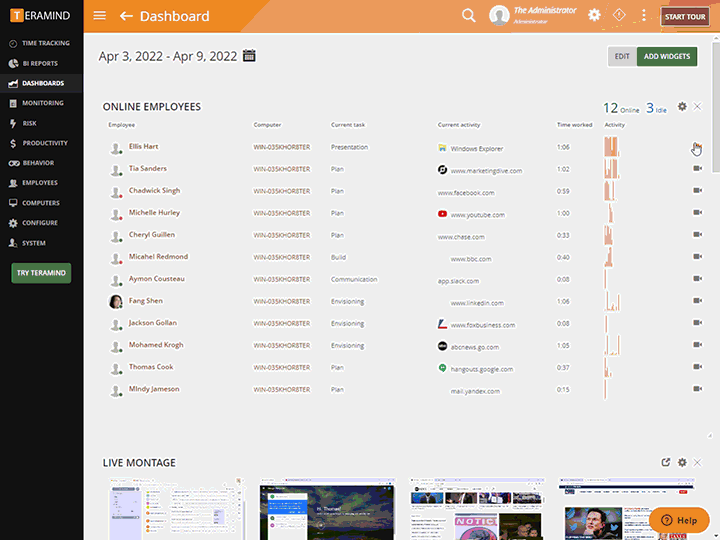Software for monitoring employees is a kind of software used by companies to track and monitor employees' activities. It allows employers to gather data on various aspects of the behavior of employees including internet use and application usage, keystrokes and even screen shots. The software for monitoring employees has a primary purpose to increase employee productivity, make sure that company policies are followed as well as protect sensitive information and deal with any security issues. When selecting an employee tracking software, there are many things to consider. Be aware of these important aspects: Features- Decide the features you need based on the requirements of your company. Common features include activity monitoring, website blocking, keystroke logs, application usage tracking along with email monitoring and report generation. Choose features that are compatible with your monitoring goals.
Compliance and Privacy- Ensure that the software is compliant with legal and ethical guidelines in the monitoring of employees. Learn about the applicable laws and regulations within your region, including privacy and data protection laws. Look for software that is clear and customizable features that ensure the privacy rights of employees.
User-Friendliness: Take into consideration the software's usability and accessibility. Simple setup and a user-friendly interface will simplify the implementation and help you save time. Find customizable dashboards, intuitive reporting tools and other options that allow you to quickly explore and understand the data you have collected.
Integration and compatibility - Make sure that your software will integrate seamlessly with the current IT infrastructure that you are using and any systems you are using, such as email clients collaborative platforms, software for managing projects and operating systems. Compatibility permits seamless monitoring of your systems without disrupting regular processes.
Data Security- Evaluate the security measures implemented by the software to secure the data collected. Data encryption, storage in a secure setting, access control, and the compliance to security requirements are all vital. Verify that the vendor of software has a good security record and robust data protection practices.
Scalability- The software should be capable of scaling up or down according to the growth of your company. If you are planning to expand your workforce or opening new locations, choose software that is able to easily scale up to meet your evolving needs.
Analytical Reporting: Check the software's analytics and reporting capabilities. Features that provide comprehensive insights into the productivity of employees, their time management, and other trends are important to look for. Customized analytics and reports can assist you in identifying areas for improvement and help you make better decisions.
Customer Support - Assess the quality of the customer service provided by the vendor. Assess their availability, responsiveness and the quality of technical support. When problems arise, excellent customer service guarantees that you receive immediate assistance.
Cost- Take a look at the pricing model for the software, regardless of whether it's a one-time purchase or subscription-based. Learn about the pricing model that includes any additional charges for support updates or additional features. Try to balance the price of your product in relation to its worth and features.
Employee Communication and Transparency- Establish clear communication with your employees about the implementation of software for monitoring. Explain clearly the reason as well as the scope and the expectations of the monitoring. Ensure that they are aware of their privacy rights and address any issues.
Consider these factors to make a well-informed decision. Choose the employee monitoring software that meets your company's needs while respecting employees' privacy. See the most popular employee monitoring services for website info.

What Are The Features Of Employee Monitoring Software And What Are The Differences Between Them?
The software offers a range of options that let users to analyze and monitor the activities of employees. Different software applications may have different features, but these are the most popular. It provides a complete view of the time employees spend working.
Keystroke Logging Keystroke logs record every keystroke that employees make. It can help to identify productivity issues, detect unauthorised activity, and collect evidence, if needed.
Screenshots or Screen Recording Screen Recording - Certain software can take regular screenshots from computer screens, while others record their screens in real-time. This feature helps keep track of productivity, check that compliance is maintained, and help to resolve issues.
Internet Usage Tracking - This feature tracks employees' online activities, such as visited websites, search queries, and downloads. It is used to identify excessive browsing that's not connected to work, potential security risks, or infractions.
Application Usage Tracking - This feature monitors the apps used by employees during work hours. It provides insight into which applications employees use most frequently and assists in identifying any inappropriate or illegal usage.
Email Monitoring: Employers can monitor emails sent and received by employees, as well as attachments, as well as the content of the email. It assists in ensuring compliance with company policies to prevent data leaks and investigate any suspicious activities.
Document and File Tracking This feature tracks access to files and changes in the file. It helps protect sensitive information and monitor collaborative work on documents, and ensure compliance to the security guidelines for data.
Remote Monitoring- Remote monitoring capabilities let employers monitor employees who work remotely or in various locations. Employers are able to monitor employee activity and ensure the productivity of employees, no matter where they are.
Productivity Analysis: Employee monitoring software typically includes productivity analysis tools that provide insights into employee productivity, work patterns, and time allocation. These analyses help optimize workflow and identify areas of improvement.
Reporting and AnalyticsA robust set of analytics and reporting tools generate detailed reports and visualizations using the data collected. These reports can give important information on employee performance, the allocation of time and resources.
Software solutions that include policies and compliance features can assist in ensuring compliance to company and industry guidelines and rules. Employers can define and enforce policies related to acceptable use of computers as well as internet access and data security.
Alerts and Notifications: Alerts & notifications alert employers and managers of certain activities and events. As an example, they could alert users to avoid excessive use of the Internet, attempts at accessing restricted websites, or other unusual behavior.
Be aware that these features are available in different software options for monitoring employees. Take into consideration the features of software that meet your goals for monitoring and adhere to the ethical and legal standards within your region. View the recommended time tracking monitoring services for blog advice.

What Is The Best Software For Tracking Employees? Does It Adhere With Compliance And Privacy Law
Monitoring software for employees must be in compliance with laws regarding privacy and compliance. The legal requirements for compliance will vary from jurisdiction-to-jurisdiction, but these are the most common methods that software for monitoring employees is compliant with the laws on privacy and compliance Consent and Notice Many jurisdictions mandate informed consent for employees and prior notification of the monitoring activity. The software for monitoring employees includes features that allow employers to communicate the policies of their monitoring clearly to staff. This could be accomplished by sending written notices to employees, getting their permission using consent forms, or by implementing guidelines for monitoring in a manual.
Transparent Monitoring Policy: Employee monitoring software encourages transparency, by making sure that employees are aware of the different types of data collected along with their purposes and the extent to which monitoring is carried out. A clear, complete policy will help employees know their rights in terms of privacy, as well as the limits of monitoring.
Data Minimization- To comply with privacy laws Employee monitoring software typically employs data minimization principles. This means only required data is collected and retained. Inappropriate or unnecessary data are avoided. By restricting data collection to the essentials to monitor purposes the software decreases the risk of privacy and increases compliance.
Anonymization and Aggregation- Some software for monitoring employees collects and anonymizes data to protect employee privacy further. Anonymization eliminates all personal identifiable information (PII) and makes it impossible to link data to individuals. Aggregation uses data from many employees to produce information for a large group without identifying any individual.
Secure Data Store and encryption Employee monitoring software ensures that the security of data collected first. It generally uses secure data storage practices and encryption methods to shield data from unauthorized access, breaches, or disclosures that are accidental. Secure data is also important in transit, as well in the rest of the data.
Access Controls and Restricted Permissions For compliance purposes, employee monitoring software often provides granular access controls and permissions. Employers are able to limit access to monitoring data to only those who need it legitimately, like HR employees or administrators.
Rights of Employees Rights- Respecting employee's rights means ensuring compliance with privacy legislation. Employee monitoring software includes options that allow employees to access their personal monitoring information and request changes. Employees can now make use of their rights in case of privacy breaches and make complaints.
Conformity with Data Protection Regulations - Employee monitoring software was developed to comply with data protection regulations like the General Data Protection Regulation in the European Union (GDPR) or the California Consumer Privacy Act in the United States (CCPA). The compliance process involves the implementation of measures to protect personal data as well as respecting rights of the data subject and ensuring the lawful processing of data.
In addition to employing tools for monitoring employees businesses should also seek out legal experts and stay current on laws and rules in their respective jurisdictions. Complying with privacy and compliance laws requires an integrated approach that goes beyond software. This includes clearly defined policies, employee education and ongoing monitoring of compliance. View the top rated employee monitoring services for more advice.
